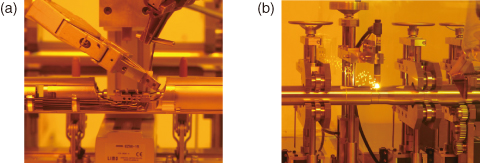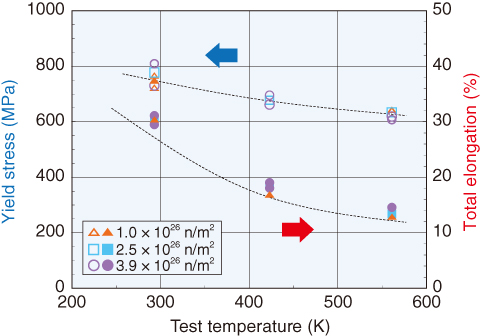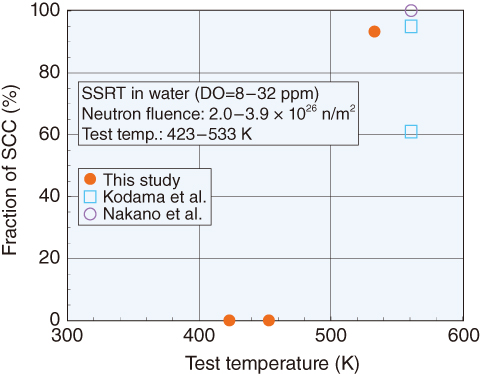
Fig.4-28 Assembling works in hot cell

Fig.4-29 Result of tensile test in air

Fig.4-30 SCC fracture rate measured by SSRT
Irradiation-assisted stress corrosion cracking (IASCC) is recognized as one of the key safety issues for managing the core components of light water reactors (LWRs). We plan to do in situ crack-propagation experiments to simulate IASCC in the Japan materials testing reactor (JMTR).
To perform these experiments, specimens must be irradiated up to the threshold of IASCC. Next, the specimens are to be relocated to in-pile test capsules and the capsules are to be assembled. Two technical hurdles remain to be solved: one is the development of welding and assembling techniques appropriate for capsules in a hot cell, and the other is the development of methods to evaluate the integrity of pre-irradiation capsules that will be irradiated in the JMTR.
We therefore developed a remote-welding apparatus that can rotate a capsule to perform circumferential welding. We tested the resulting welds many times by varying the parameters of rotation speed and welding current. However, obtaining a suitable weld in a single welding pass proved impossible. Thus, we used two-pass circumferential welding. This method efficiently preheats the first weld, which is then completely by the second weld, making it possible to weld and assemble capsules in the hot cell. Fig.4-28 shows photographs of welding and assembling.
We also evaluated the integrity of the structural material of the capsules. When specimens are irradiated, the structural materials of the pre-irradiation capsule also receive irradiation up to the threshold fluence of IASCC. Thus, we must evaluate the integrity of the heavily irradiated structural materials of the capsules.
Specimens were fabricated from stainless steel irradiated in the JMTR for over 20 years (neutron irradiation at 1.0−3.9 × 1026 n/m2). Tensile tests in air and slow-strain-rate testing (SSRT) in water were performed.
Fig.4-29 shows the result of the tensile tests, and Fig.4-30 shows the SCC fracture rate determined after SSRT.
Under irradiation, the temperature of the outer tube of the capsule is estimated to be 423 K. These results show that the structural material of the capsule is sufficiently ductile and will not undergo SCC fracturing at the operating temperature.
By overcoming these two hurdles, we can perform the in-pile IASCC tests required to investigate life-time management, which is important for evaluating the safety of LWRs.